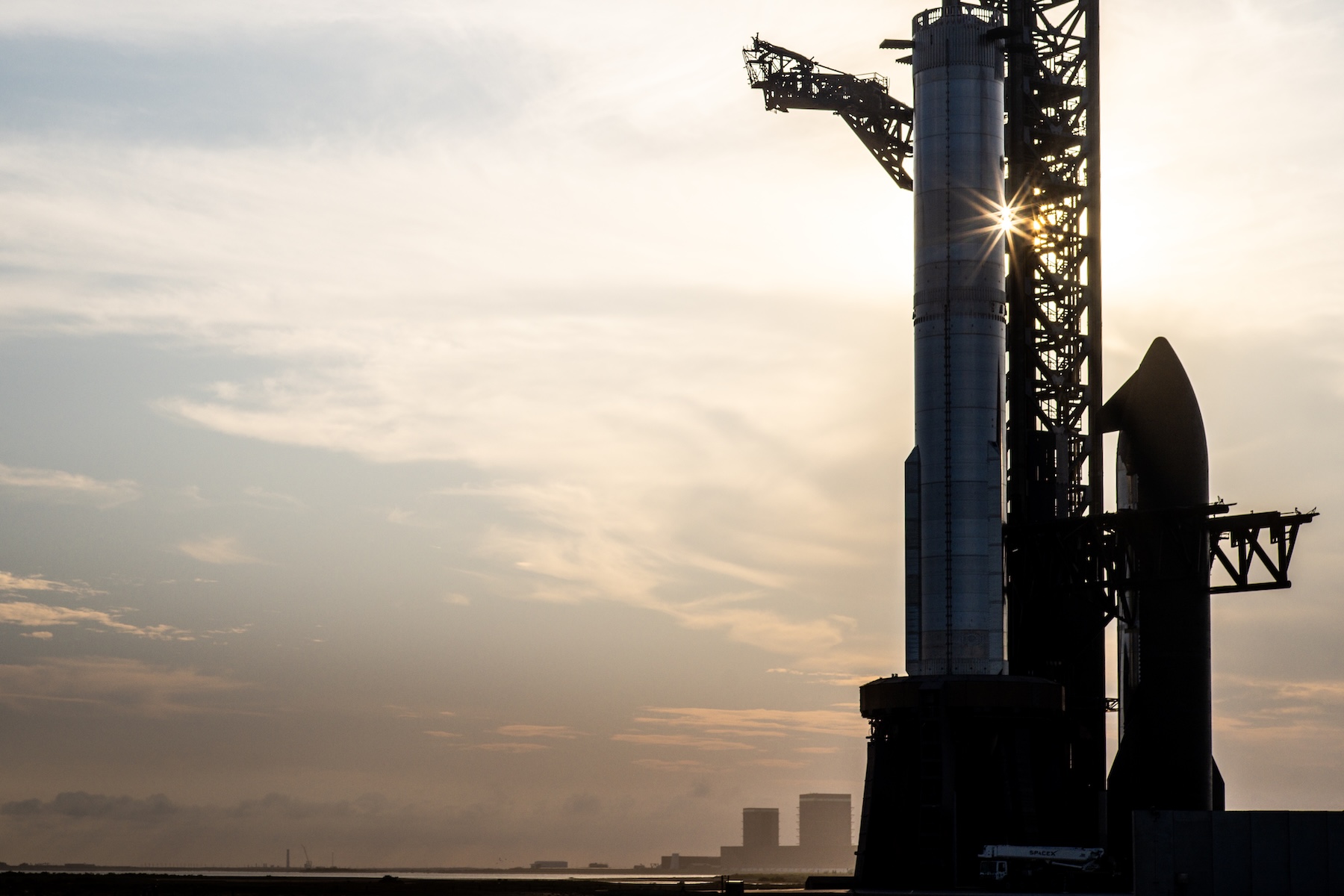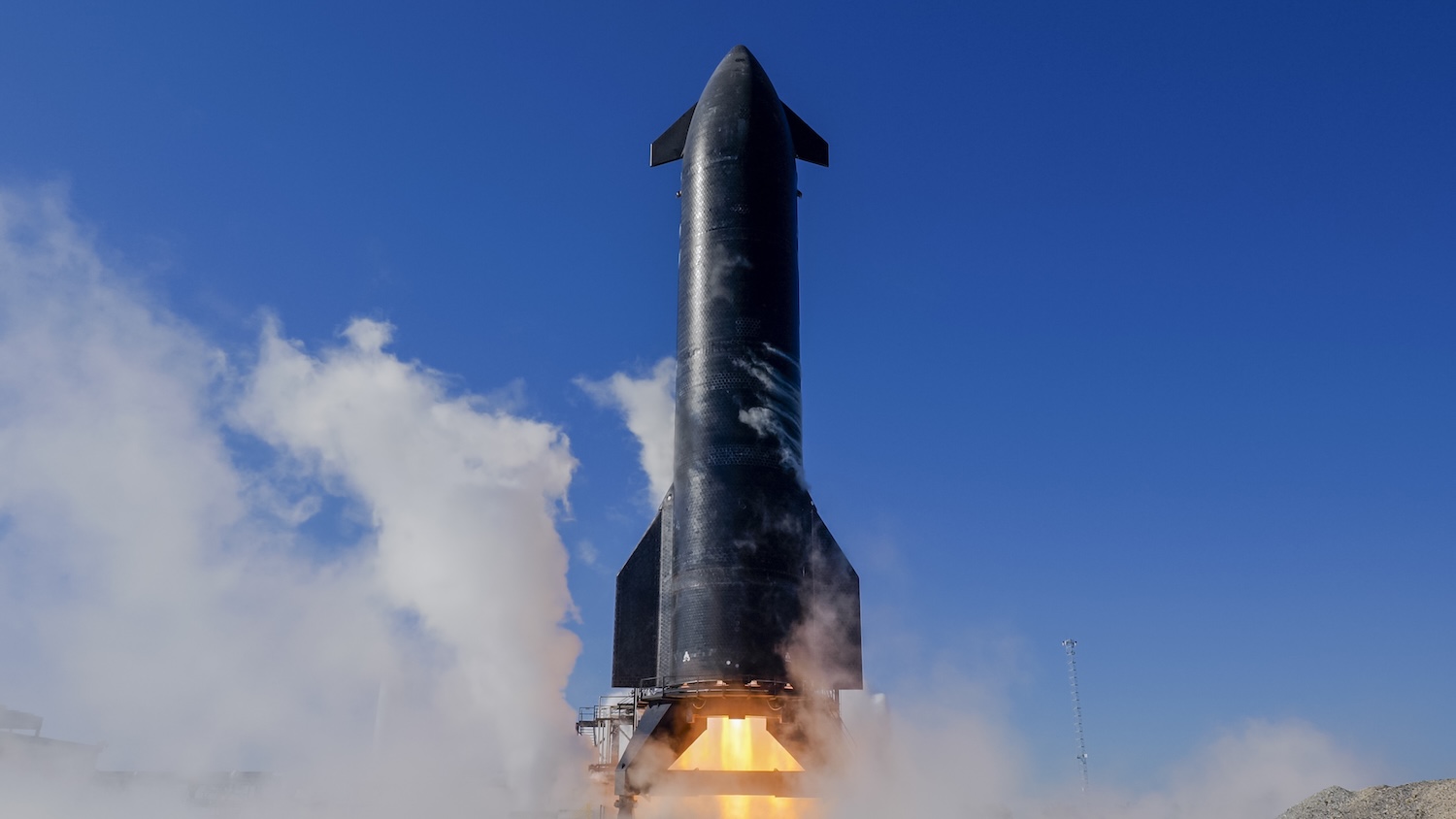SpaceX had high hopes for Starship in 2025, but it's been one setback after another.
A fireball erupts around SpaceX's Starship rocket in South Texas late Wednesday night. Credit: LabPadre
SpaceX's next Starship rocket exploded during a ground test in South Texas late Wednesday, dealing another blow to a program already struggling to overcome three consecutive failures in recent months.
The late-night explosion at SpaceX's rocket development complex in Starbase, Texas, destroyed the bullet-shaped upper stage that was slated to launch on the next Starship test flight. The powerful blast set off fires around SpaceX's Massey's Test Site, located a few miles from the company's Starship factory and launch pads.
Live streaming video from NASASpaceflight.com and LabPadre—media organizations with cameras positioned around Starbase—showed the 15-story-tall rocket burst into flames shortly after 11:00 pm local time (12:00 am EDT; 04:00 UTC). Local residents as far as 30 miles away reported seeing and feeling the blast.
SpaceX confirmed the Starship, numbered Ship 36 in the company's inventory, "experienced a major anomaly" on a test stand as the vehicle prepared to ignite its six Raptor engines for a static fire test. These hold-down test-firings are typically one of the final milestones in a Starship launch campaign before SpaceX moves the rocket to the launch pad.
The explosion occurred as SpaceX finished up loading super-cold methane and liquid oxygen propellants into Starship in preparation for the static fire test. The company said the area around the test site was evacuated of all personnel, and everyone was safe and accounted for after the incident. Firefighters from the Brownsville Fire Department were dispatched to the scene.
"Our Starbase team is actively working to safe the test site and the immediate surrounding area in conjunction with local officials," SpaceX posted on X. "There are no hazards to residents in surrounding communities, and we ask that individuals do not attempt to approach the area while safing operations continue."
Picking up the pieces
Earlier Wednesday, just hours before the late-night explosion at Starbase, an advisory released by the Federal Aviation Administration showed SpaceX had set June 29 as a tentative launch date for the next Starship test flight. That won't happen now, and it's anyone's guess when SpaceX will have another Starship ready to fly.
Massey's Test Site, named for a gun range that once occupied the property, is situated on a bend in the Rio Grande River, just a few hundred feet from the Mexican border. The test site is currently the only place where SpaceX can put Starships through proof testing and static fire tests before declaring the rockets are ready to fly.
The extent of the damage to ground equipment at Massey's was not immediately clear, so it's too soon to say how long the test site will be out of commission. For now, though, the explosion leaves SpaceX without a facility to support preflight testing on Starships.
The videos embedded below come from NASASpaceflight.com and LabPadre, showing multiple angles of the Starship blast.
The explosion at Massey's is a reminder of SpaceX's rocky path to get Starship to this point in its development. In 2020 and 2021, SpaceX lost several Starship prototypes to problems during ground and flight testing. The visual of Ship 36 going up in flames harkens back to those previous explosions, along with the fiery demise of a Falcon 9 rocket on its launch pad in 2016 under circumstances similar to Wednesday night's incident.
SpaceX has now launched nine full-scale Starship rockets since April 2023, and before the explosion, the company hoped to launch the 10th test flight later this month. Starship's track record has been dreadful so far this year, with the rocket's three most recent test flights ending prematurely. These setbacks followed a triumphant 2024, when SpaceX made clear progress on each successive Starship suborbital test flight, culminating in the first catch of the rocket's massive Super Heavy booster with giant robotic arms on the launch pad tower.
Stacked together, the Super Heavy booster stage and Starship upper stage stand more than 400 feet tall, creating the largest rocket ever built. SpaceX has already flown a reused Super Heavy booster, and the company has designed Starship itself to be recoverable and reusable, too.
After last year's accomplishments, SpaceX appeared to be on track for a full orbital flight, an attempt to catch and recover Starship itself, and an important in-space refueling demonstration in 2025. The refueling demo has officially slipped into 2026, and it's questionable whether SpaceX will make enough progress in the coming months to attempt recovery of a ship before the end of this year.

A Super Heavy booster and Starship upper stage are seen in March at SpaceX's launch pad in South Texas, before the ship was stacked atop the booster for flight. The Super Heavy booster for the next Starship flight completed its static fire test earlier this month. Credit: Brandon Bell/Getty Images
Ambition meets reality
SpaceX debuted an upgraded Starship design, called Version 2 or Block 2, on a test flight in January. It's been one setback after another since then.
The new Starship design is slightly taller than the version of Starship that SpaceX flew in 2023 and 2024. It has an improved heat shield to better withstand the extreme heat of atmospheric reentry. SpaceX also installed a new fuel feed line system to route methane fuel to the ship's Raptor engines, and an improved propulsion avionics module controlling the vehicle's valves and reading sensors.
Despite—or perhaps because of—all of these changes for Starship Version 2, SpaceX has been unable to replicate the successes it achieved with Starship in the last two years. Ships launched on test flights in January and March spun out of control minutes after liftoff, scattering debris over the sea, and in at least one case, onto a car in the Turks and Caicos Islands.
SpaceX engineers concluded the January failure was likely caused by intense vibrations that triggered fuel leaks and fires in the ship's engine compartment, causing an early shutdown of the rocket's engines. Engineers said the vibrations were likely in resonance with the vehicle's natural frequency, intensifying the shaking beyond the levels SpaceX predicted.
The March flight failed in similar fashion, but SpaceX's investigators determined the most probable root cause was a hardware failure in one of the ship's engines, a different failure mode than two months before.
During SpaceX's most recent Starship test flight last month, the rocket completed the ascent phase of the mission as planned, seemingly overcoming the problems that plagued the prior two launches. But soon after the Raptor engines shut down, a fuel leak caused the ship to begin tumbling in space, preventing the vehicle from completing a guided reentry to test the performance of new heat shield materials.

File photo of a Starship static fire in May at Massey's Test Site.
SpaceX is working on a third-generation Starship design, called Version 3, that the company says could be ready to fly by the end of this year. The upgraded Starship Version 3 design will be able to lift heavier cargo—up to 200 metric tons—into orbit thanks to larger propellant tanks and more powerful Raptor engines. Version 3 will also have the ability to refuel in low-Earth orbit.
Version 3 will presumably have permanent fixes to the problems currently slowing SpaceX's pace of Starship development. And there are myriad issues for SpaceX's engineers to solve, from engine reliability and the ship's resonant frequency, to beefing up the ship's heat shield and fixing its balky payload bay door.
Once officials solve these problems, it will be time for SpaceX to bring a Starship from low-Earth orbit back to the ground. Then, there's more cool stuff on the books, like orbital refueling and missions to the Moon in partnership with NASA's Artemis program. NASA has contracts worth more than $4 billion with SpaceX to develop a human-rated Starship that can land astronauts on the Moon and launch them safely back into space.
The Trump administration's proposed budget for NASA would cancel the Artemis program's ultra-expensive Space Launch System rocket and Orion crew capsule after two more flights, leaving commercial heavy-lifters to take over launching astronauts from the Earth to the Moon. SpaceX's Starship, already on contract with NASA as a human-rated lander, may eventually win more government contracts to fill the role of SLS and Orion under Trump's proposed budget. Other rockets, such as Blue Origin's New Glenn, are also well-positioned to play a larger role in human space exploration.
NASA's official schedule for the first Artemis crew landing on the Moon puts the mission some time in 2027, using SLS and Orion to transport astronauts out to the vicinity of the Moon to meet up with SpaceX's Starship lunar lander. After that mission, known as Artemis III, NASA would pivot to using commercial rockets from Elon Musk's SpaceX and Jeff Bezos' Blue Origin to replace the Space Launch System.
Meanwhile, SpaceX's founder and CEO has his sights set on Mars. Last month, Musk told his employees he wants to launch the first Starships toward the Red Planet in late 2026, when the positions of Earth and Mars in the Solar System make a direct journey possible. Optimistically, he would like to send people to Mars on Starships beginning in 2028.
All of these missions are predicated on SpaceX mastering routine Starship launch operations, rapid reuse of the ship and booster, and cryogenic refueling in orbit, along with adapting systems such as life support, communications, and deep space navigation for an interplanetary journey.
The to-do list is long for SpaceX's Starship program—too long for Mars landings to seem realistic any time in the next few years. NASA's schedule for the Artemis III lunar landing mission in 2027 is also tight, and not only because of Starship's delays. The development of new spacesuits for astronauts to wear on the Moon may also put the Artemis III schedule at risk. NASA's SLS rocket and Orion spacecraft have had significant delays throughout their history, so it's not a sure thing they will be ready in 2027.
While it's too soon to know the precise impact of Wednesday night's explosion, we can say with some confidence that the chances of Starship meeting these audacious schedules are lower today than they were yesterday.
.png)




